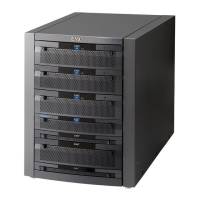210
Celerra Network Server Command Reference Manual
The nas Commands
size equal to or greater than the size specified. When specifying the
volume by size, enter an integer between 1 and 1024, then specify G
for gigabytes (default) or M for megabytes.
[-storage <system_name>]
Specifies the storage system on which one or more volumes will
be created, to be added to the storage pool.
Note: Extending the storage pool by size is for system-defined storage
pools only. To successfully extend a system-defined storage pool, the
is_dynamic attribute must be set to n, and there must be enough
available disk volumes to satisfy the request.
-shrink {<name>|id=<id>} -volumes
<volume_name>[,<volume_name>,...]
Shrinks the storage pool by the specified unused volumes. The
is_dynamic option must be set to n before shrinking system-defined
storage pools.
SEE ALSO Managing Celerra Volumes and File Systems with Automatic Volume
Management, Managing Celerra Volumes and File Systems Manually,
Controlling Access to Celerra System Objects, Using TimeFinder/FS, Near
Copy, and Far Copy with Celerra, fs_timefinder, nas_fs, nas_volume,
and nas_slice.
BACKEND OUTPUT Celerra Network Servers with a CLARiiON backend support the
following system-defined storage pools: clar_r1,
clar_r5_performance, clar_r5_economy, clarata_r3, clarata_archive,
cm_r1, cm_r5_performance, cm_r5_economy, cmata_r3, and
cmata_archive.
Disk types when using CLARiiON are: CLSTD and CLATA, and for
CLARiiON backends involving mirrored disks: CMSTD, and
CMATA.
Celerra Network Servers with a Symmetrix backend support the
following system-defined storage pools: symm_std,
symm_std_rdf_src, symm_ata, symm_ata_rdf_src.
For user-defined storage pools, the difference in output is in the disk
type. Disk types when using a Symmetrix are: STD, R1STD, R2STD,
BCV, R1BCV, R2BCV, ATA, R1ATA, R2ATA, BCVA,
R1BCA,
R2BCA.

